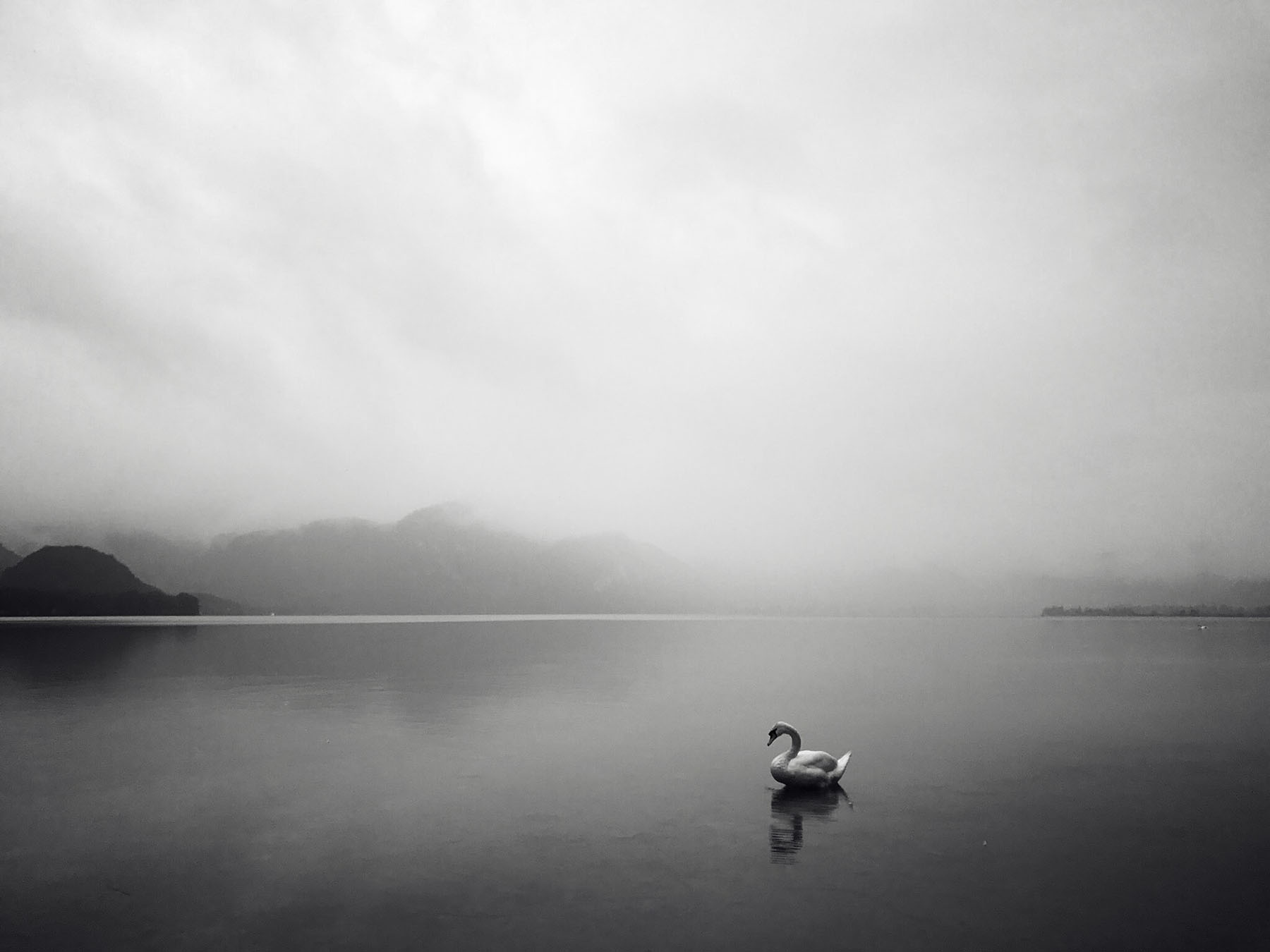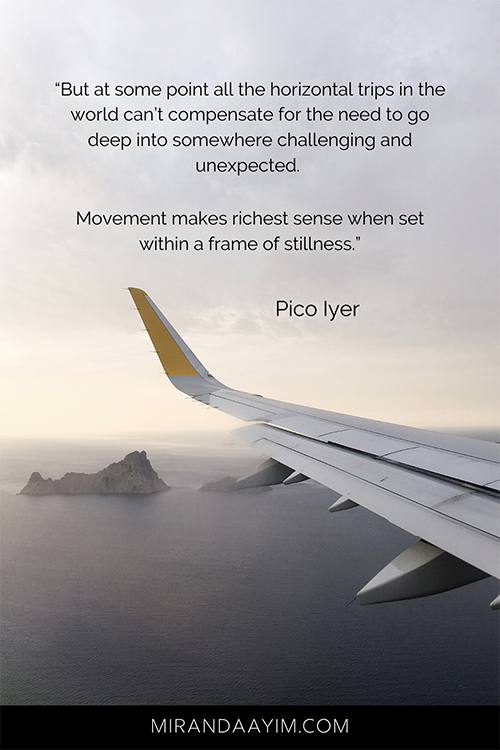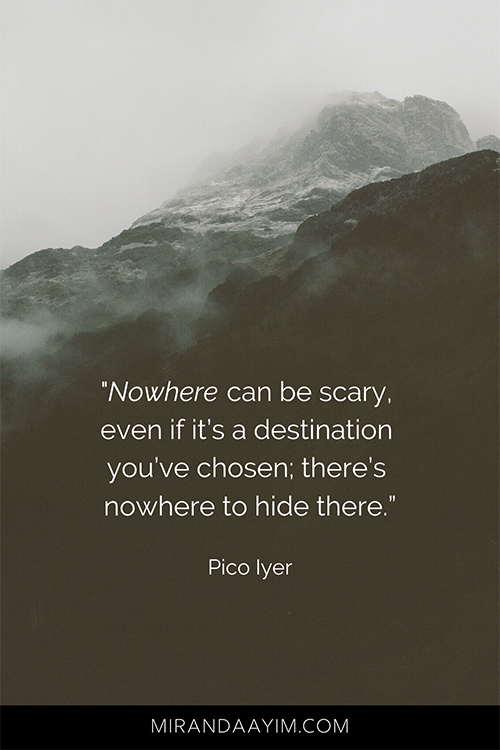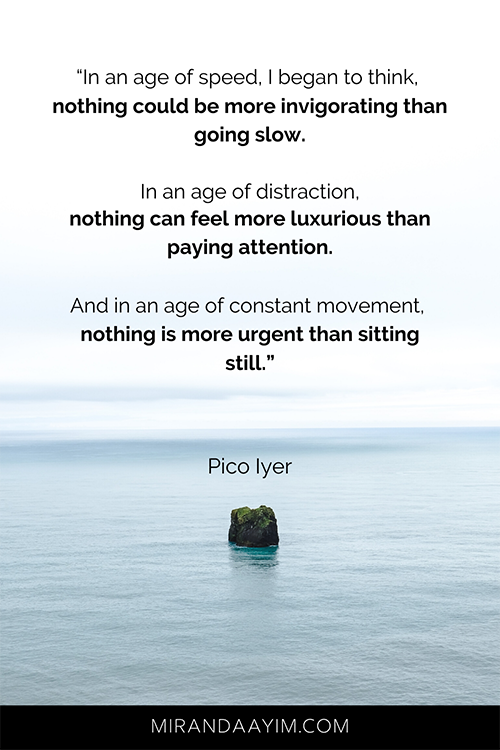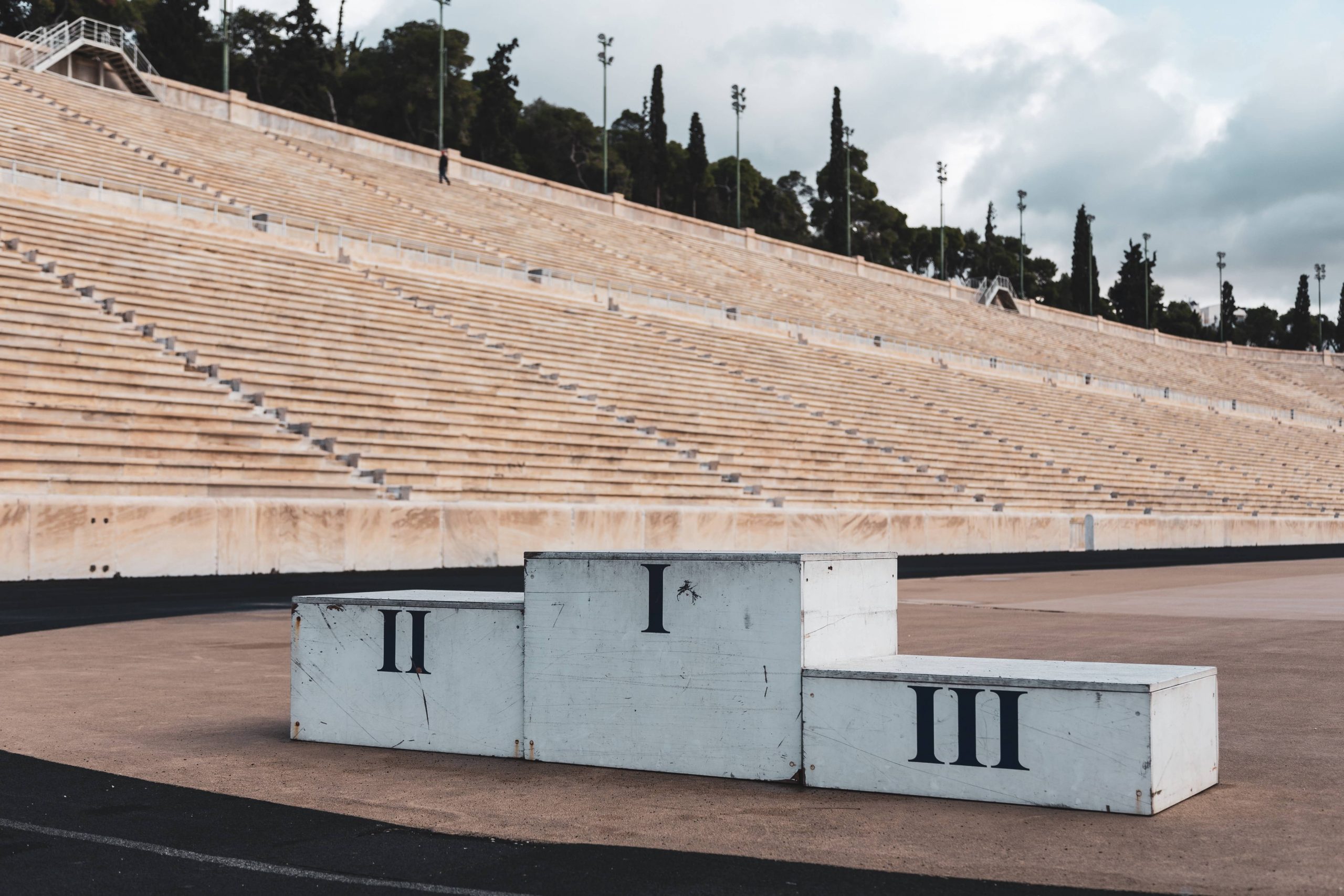Book: The Art of Stillness: Adventures in Going Nowhere by Pico Iyer
Summary of the summary: Sitting still (or going Nowhere) is “how many of us get what we most crave and need in our accelerated lives.”
Takeaway: Going Nowhere gives you the opportunity to synthesize lessons, emotions and experiences in order to create a truly fulfilling, balanced life. Stillness adds meaning to the motion.
I usually refer to stillness as a lack of noise or distraction, or, alternatively, a state of inner balance, but there’s another way to describe stillness: lack of movement.
In a book about “Adventures in Going Nowhere” (the book’s subtitle), it’s either ironic or perfectly fitting, that the author is Pico Iyer, an internationally known travel writer. Despite his passion for travel, he has found great beauty and meaning in stillness. In fact, his personal website is a testament to that.
Even though “going nowhere” doesn’t seen like much of an adventure, Iyer paints a brilliant picture of slow transformation, abiding calm, and focused appreciation in the midst of a world that’s growing increasingly busy, increasingly distracted and increasingly chaotic.
He explores “Nowhere”—its soft language, deep tradition, and sometimes frighteningly lonely customs.
I’ve compiled some significant quotes from The Art of Stillness, with brief explanatory notes throughout. All quotes are organized under the same titles as are in the book.
Note:
All quotes are Pico Iyer’s, unless otherwise indicated.
I’ve added bold throughout the text. Those are my own additions for emphasis.
You can check out Pico Iyer’s TED Talk on this same topic below:
Introduction: Going Nowhere
Iyer opens the book with a trip up to a monastery in the mountains where he meets Leonard Cohen. Yes, the famous musician known for his wordsmithery, good looks and full exploitation of the rockstar lifestyle. It’s a peculiar way to start a book about stillness, until you learn that Cohen—in his sixties at the time the book was published—had been adhering to a life of monastic rigidity for the past thirty years.
Cohen’s explanation of the drastic change in lifestyle (through the words of Iyer): “Being in this remote place of stillness had nothing to do with piety or purity, he assured me; it was simply the most practical way he’d found of working through the confusion and terror that had long been his bedfellows.”
“Going nowhere [is] the grand adventure that makes sense of everywhere else.” – Iyer paraphrasing Cohen.
Iyer and Cohen continue in their mountain-top discussion, astutely noting that “making a living and making a life sometimes point in opposite directions.”
“Stillness is not just an indulgence for those with enough resources—it’s a necessity for anyone who wishes to gather less visible resources.”
“[T]alking about stillness is really a way of talking about clarity and sanity and the joys that endure.”
Chapter 1: Passage to Nowhere
Iyer gives a brief account of his personal path to stillness—or, as he puts it, his passage to Nowhere. He paints the familiar picture of a successful man running full tilt in an exciting career, yet always with the nagging feeling that something was missing.
He realizes that all his life has been pointed towards getting Somewhere. However, despite that initial aim, he finds that “the nowhere I was interested in had more corners and dimensions than I could possible express to [my father] (or myself), and somehow seemed larger and more unfathomable than the endlessly diverting life I’d known in the city; it opened onto a landscape as vast as those of the Morocco and Indonesia and Brazil I had come to know, combined.”
He then decides to leave New York and spend a year in Kyoto, Japan in a small, single room apartment.
“Going nowhere…isn’t about turning your back on the world; it’s about stepping away now and then so that you can see the world more clearly and love it more deeply.”
“Most of our problems—and therefore our solutions, our peace of mind—lie within.”
“So much of our lives takes place in our heads—in memory or imagination, in speculation or interpretation—that sometimes I feel that I can best change my life by changing the way I look at it.”
“But at some point all the horizontal trips in the world can’t compensate for the need to go deep into somewhere challenging and unexpected. Movement makes richest sense when set within a frame of stillness.”
“Heaven is the place where you think of nowhere else.”
“…finding what feels like real life, that changeless and inarguable something behind all our shifting thoughts, is less a discovery than a recollection.”
“One of the beauties of Nowhere is that you never know where you’ll end up when you head in its direction.”
Chapter 2: The Charting of Stillness
He invokes the beauty and artistry of silence when he reflects on his own profession of writing: “Our creations come not when we’re out in the world, gathering impressions, but when we’re sitting still, turning those impressions into sentences.”
“Sitting still is our workplace, sometimes our battlefield.”
He continues on in the same vein by sharing what he calls “Portraits of Nowhere,” a work by Matthieu Ricard, a French monk whom many deem to be the happiest man in the world.
Sometime before they met, Ricard had retreated to a cabin in Nepal (once again, on the top of a mountain) and over the course of a year took photos once or twice a week from the front door of his mountain retreat.
In the same location, we watch as fall gives way to winter which melts into spring which welcomes summer. We note the shift between soft morning rays to sharp afternoon shadows to somber evening darkness. We observe the variation that clouds, wind, rain and light brings to a landscape. The incredible fluctuation of the “same” scenery gives way to a settled sense of awe.
“The book, which [Ricard] called Motionless Journey, might almost have been an investigation into how everything changes and doesn’t change at all—how the same place looks different even as you’re not really going anywhere.”
“But what made it most haunting was that, at heart, it was a description of an inner landscape. This is what your mind—your life—looks like when you’re going nowhere.”
Chapter 3: Alone in the Dark
Iyer briefly addresses involuntary stillness. There is a suffocating nature to being Nowhere if not chosen freely, as is the case with prisoners or the disabled, or those in extreme poverty or under controlling regimes. They have external forces forbidding them to move or travel.
He also talks about the dark side of stillness—what comes when you’re unprepared for what’s within.
“Nowhere can be scary, even if it’s a destination you’ve chosen; there’s nowhere to hide there.”
Speaking of Emily Dickinson, known for rarely leaving her home: “A life of stillness can sometimes lead not to art but to doubt or dereliction; anyone who longs to see the light is signing on for many long nights alone in the dark.”
He also warns those tempted to use stillness (like that of a monastery) as an escape: “As in any love affair, the early days of a romance with stillness give little sign of the hard work to come.”
“One of the laws of sitting still, in fact, is that ‘if you enter it with the set purpose of seeking contemplation, or, worse still, happiness, you will find neither. For neither can be found unless it is first in some sense renounced.’” – Iyer quoting Thomas Merton
Chapter 4: Stillness Where It’s Needed Most
Iyer reflects on the increasing pace of the modern world and how much has changed since the days of ancient philosophers and wisdom teachers. He suggests extra attention on this subject of stillness in a time when we desperately need it.
“Researchers in the new field of interruption science have found that it takes an average of twenty-five minutes to recover from a phone call. Yet such interruptions come every eleven minutes—which means we’re never caught up with our lives.”
“It’s easy to feel as if we’re standing two inches away from a huge canvas that’s noisy and crowded and changing with every microsecond. It’s only by stepping farther back and standing still that we can begin to see what that canvas (which is our life) really means, and to take in the larger picture.”
“The people who seem wisest about the necessity of placing limits on the newest technologies are, often, precisely the ones who helped develop those technologies, which have bulldozed over so many of the limits of old.”
“To me, the point of sitting still is that it helps you see through the very idea of pushing forward; indeed, it strips you of yourself, as of a coat of armor, by leading you into a place where you’re defined by something larger.”
“If [sitting still] does have benefits, they lie within some invisible account with a high interest rate but very long-term yields…”
A common expression in Kyoto: “Don’t just do something. Sit there.”
Chapter 5: A Secular Sabbath
“The need for an empty space, a pause, is something we have all felt in our bones; it’s the rest in a piece of music that gives it resonance and shape.”
Iyer takes the wisdom of a long-held Jewish tradition and applies it to modern life for the purpose of creating space to come in contact with stillness.
“It is… ‘a cathedral in time rather than in space’; the one day a week we take off becomes a vast empty space through which we can wander, without agenda, as through the light-filled passageways of Notre Dame.” – Iyer quoting Jewish theologian Abraham Joshua Heschel
“But as fast as geography is coming under our control, the clock is exerting more and more tyranny over us.”
“And the more we can contact others, the more, it sometimes seems, we lose contact with ourselves.”
Chapter 6: Coming Back Home
“The point of gathering stillness is not to enrich the sanctuary or mountaintop but to bring that calm into the motion, the commotion of the world.”
Iyer finishes the book by reflecting on how stillness brings meaning to motion. He notes how deeper reserves are accessed, deeper connections are fostered, and deeper memories are made when built on a foundation of stillness. For as much as we think of stillness as inaction, “Stillness has nothing to do with settledness or stasis.”
“Very often, I’ll sit for weeks composing a work such as this one, making an outline, a linear A-B-C guide. The longer I sit still, however, the more those logical structures get turned inside out, till something beyond me is propelling me out of Nowhere down an entirely unexpected sequence of Q-C-A.”
“One of the strange laws of the contemplative life is that in it you do not sit down and solve problems: you bear with them until they somehow solve themselves. Or until life solves them for you.” – Thomas Merton
“In an age of speed, I began to think, nothing could be more invigorating than going slow.
In an age of distraction, nothing can feel more luxurious than paying attention.
And in an age of constant movement, nothing is more urgent than sitting still.”

